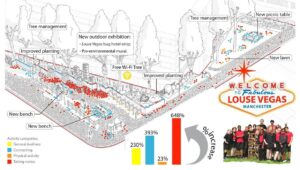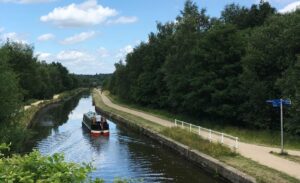How can improvements in urban design help build the wellbeing evidence base?
Here in Manchester we are making use of real world urban design interventions – led by policy makers, place managers and designers – as valuable opportunities to understand how a policy or program impacts wellbeing, by using strong ‘before and after’ impact evaluations.
Five Ways to Wellbeing as outcome measures
We started with a run-down space in the city centre that was recently transformed by Manchester City Council, City Co (a city centre management company), ‘guerrilla gardeners’ and a local primary school, into a meaningful community space. We used the Five Ways to Wellbeing to steer the design as well as the as target outcomes to evaluate the wellbeing impact and saw large increases in a sense of belonging, Connect and Take Notice activities, compared to a matched control space.

This was the first step towards developing a strong evaluation, but the evidence that was generated required improvement, so we developed two new outcome measures to increase confidence that the changes we detected in outcomes represented true estimates.
New outcome measures for wellbeing impact
- MOHAWk (Method for Observing pHysical Activity and Wellbeing)
This is a direct behaviour observation tool covering three of the Five Ways to Wellbeing (Connect, Take Notice and Be Active) and was used in two recently published natural experiment studies.
- The first involved working with Southway Housing Trust to understand whether a small-scale urban street greening intervention impacted wellbeing behaviours. We did not detect increases for these behaviours and we believe this was because the intervention was not substantial enough, especially compared to other recent neighbourhood changes in the area.
- The second larger study involved partnering with Peel Land & Property who introduced improvements along an urban canal, which led to large increases in canal usage and wellbeing behaviours.

- NOURISH (Neighbourhood flOURISHing).
This tool was created as a measure of social wellbeing that can clearly be linked to a specific geographical area AND is inclusive for low literacy readers. It is being used within an exciting Grow Green ‘sponge park’ natural experiment, in a deprived area of Manchester. The project involves Guinness housing association, MCC, UoM, designers and the local community working together to co-design innovative nature based solutions that mitigate climate change impact, whilst simultaneously improving wellbeing. Compared to a baseline measure, initial findings are promising and we hope to publish these findings later this year.
New collaborations
Our current work is on one of Europe’s largest regeneration projects – Brent Cross Town (BXT).
Baseline Flourishing Index data collection will involve support from the University of Manchester’s Urban Observatory to test new digital and automated techniques that will reduce labour time, improve measures of exposure to interventions and support for the local community to share wellbeing insight, and co-interpret this information with local stakeholders. The project will also represent a unique open data collaboration with Data for London.
The end-point for our work is to provide the collaborative tools and methods that we hope will hardwire wellbeing into all urban planning and development activities.
For further details about this project please contact Jamie or Jack.
